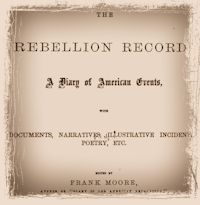November 10.— An expedition consisting of about four hundred Union troops, under the command of Colonel Foster, this day left Henderson, Ky., in pursuit of several bands of rebel guerrillas that had been for some time infesting northwestern Kentucky. The force divided itself into four columns, and was entirely successful, defeating the rebels wherever they were come up with, taking a large number of prisoners, horses, and arms.
—A party of regular cavalry, under the command of Lieutenant Ash, of the Second dragoons, on a foraging party, at a point ten miles south of Warrenton, Va., encountered a squadron of the Fifth Virginia rebel cavalry, whom they routed and put to flight, after making a gallant charge directly through their ranks.—Officers of all grades belonging to the army of the Potomac were ordered to join their respective commands within twenty-four hours.
—Captain G. W. Gilmore, with a party of Union troops, made a reconnoissance into Greenbrier County, Va. Near Williamsburgh, he captured a wagon-train belonging to the rebel General Jenkins, about to be loaded with grain; also a number of prisoners, horses, mules, etc. He set fire to the wagons and grain.—(Doc. 43.)
—General Burnside, in accordance with the orders of President Lincoln, assumed command of the army of the Potomac.—The Legislature of Georgia passed a bill to obstruct the navigable rivers of the State, and appropriated five hundred thousand dollars to aid in the work. The Governor was also authorized to impress slaves for the purpose.—Savannah Republican.
—Resistance to the draft occurred in Ozaukee County, Wis.—An enthusiastic Union meeting was held at Memphis, Tenn.



